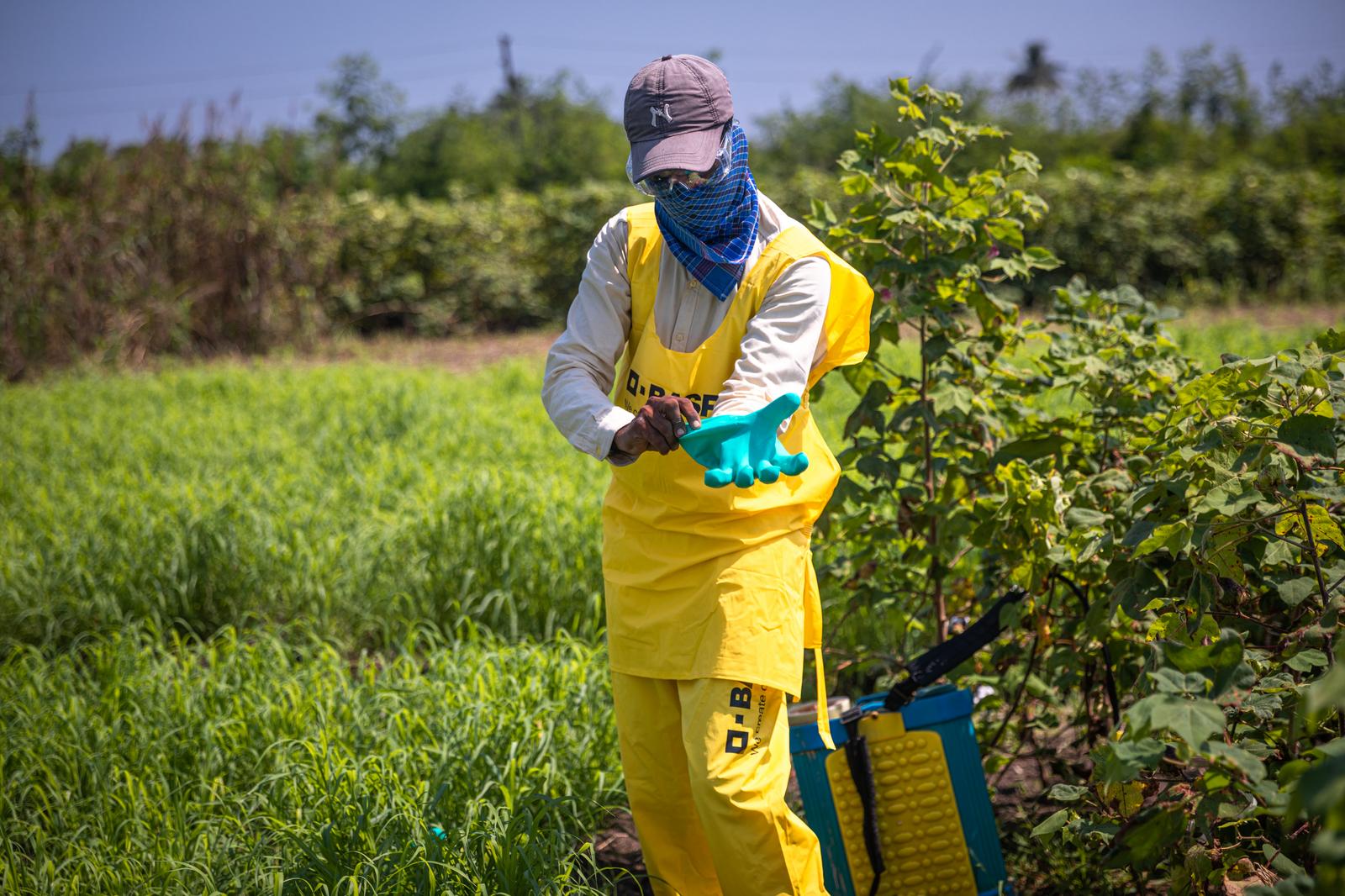How Fast Fashion Is Poisoning Our Planet
From the cotton fields to the clothing racks, the pursuit of low-cost style relies on toxic materials and polluting practices that harm our water, air, and soil. Among the many environmental consequences, chemical contamination may be the most immediate and dangerous.
The Cost of Cotton
 Vibhor, Y. (2019). Cotton Farmer Vala Gopalbhai Nathabha getting dressed in personal protective equipment (PPE) before applying pesticides. [Photograph]. Better Cotton. https://bettercotton.org/field-level-results-impact/key-sustainability-issues/pesticides-and-crop-protection-in-cotton-farming/
Vibhor, Y. (2019). Cotton Farmer Vala Gopalbhai Nathabha getting dressed in personal protective equipment (PPE) before applying pesticides. [Photograph]. Better Cotton. https://bettercotton.org/field-level-results-impact/key-sustainability-issues/pesticides-and-crop-protection-in-cotton-farming/
Cotton might look clean and natural, but its environmental impact tells another story. And that’s just the beginning. The processing of cotton into wearable fabric involves a cocktail of dyes, bleaches, and chemical agents, many of which are dumped directly into rivers and lakes. (Niinimäki et al., 2020).
Take Cambodia, for example. In a country where fashion accounts for 88% of industrial output, the consequences are stark. The industry is responsible for 60% of water pollution and 34% of chemical pollution nationwide (Niinimäki et al., 2020). These toxic discharges poisons into local waterways, endanger ecosystems, and seep into drinking water, carrying long-term health risks for surrounding communities.
Many of these chemicals, such as formaldehyde and azo dyes, are known carcinogens and endocrine disruptors. Once they enter the water system, they don’t just disappear. They linger, bioaccumulate, and impact both human and marine life for generations.
Air Pollution: A Silent Offender
While water pollution is highly visible, the fashion industry’s role in air pollution is just as severe and far less discussed. Globally, apparel production is responsible for 6–10% of greenhouse gas emissions, putting it on par with the aviation and shipping industries combined (Niinimäki et al., 2020).
Fast fashion’s carbon footprint doesn’t end with production. Many brands burn unsold or returned items, a shocking yet common practice. In an interview with Magdalena Płonka from the University of Economics and Human Sciences (AEH) in Warsaw, she points out, “Exhaust emissions from the container ships and from the fires contribute to air pollution” (Orłowska, 2023). These emissions not only contribute to climate change but also increase respiratory illnesses in heavily industrialized regions.
Chemical Contamination: The Hidden Crisis
 Mityay, D. (2020). Chemical contaminants leak into ocean water [Photograph]. Open Access Government. https://www.openaccessgovernment.org/how-is-fast-fashion-polluting-our-water/77704/
Mityay, D. (2020). Chemical contaminants leak into ocean water [Photograph]. Open Access Government. https://www.openaccessgovernment.org/how-is-fast-fashion-polluting-our-water/77704/
Chemical pollution may be the most overlooked but devastating outcome of fast fashion. Nearly every step, from pesticide-soaked cotton fields to dye-laden manufacturing, uses toxic, often carcinogenic substances. These chemicals aren’t safely contained. They leach into soil and water during rainfall or factory runoff, spreading contamination far from the original source (Orłowska, 2023).
Producing just one T-shirt involves multiple chemical treatments, each adding to the environmental burden. And when regulations are lax or nonexistent—as is often the case in low-cost manufacturing hubs—the consequences are multiplied.
This isn’t just an ecological issue. It’s a growing public health crisis.
What Can We Do?
The evidence is clear: fast fashion is an environmental hazard. The affordability of a low-cost shirt masks the unseen cost to our planet.
But we’re not powerless.
- Shop second-hand to reduce demand for new production.
- Support sustainable brands that prioritize ethical sourcing and non-toxic manufacturing.
- Buy less, but better. Choose quality over quantity.
The next time you’re tempted by a trendy new outfit, think about the price the planet is paying. Change begins with conscious choices—and the fashion industry won’t shift until we demand it.
Sources:
- Niinimäki, K., Peters, G., Dahlbo, H., Perry, P., Rissanen, T., & Gwilt, A. (2020). The environmental price of fast fashion. Nature Reviews Earth & Environment, 1(4), 189–200. https://doi.org/10.1038/s43017-020-0039-9
- Orłowska, J. (2023, October 3). Greater responsibility in lieu of “Fast fashion” – Academia. The Magazine of the Polish Academy of Sciences – PAS journals. ACADEMIA. The magazine of the Polish Academy of Sciences. https://journals.pan.pl/dlibra/publication/147024/edition/128827/content

